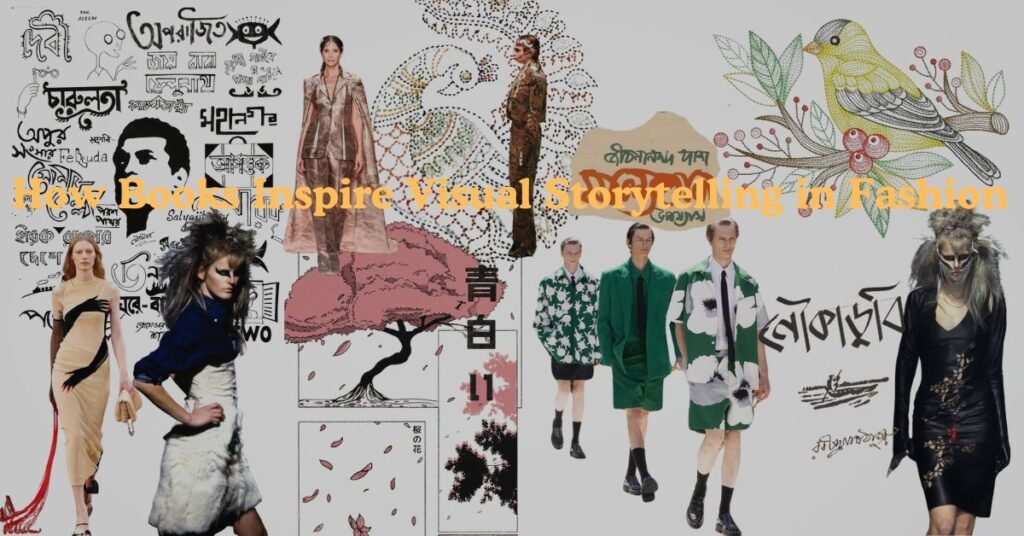
How Books Inspire Visual Storytelling in Fashion
It was a quiet evening in Dhaka, and I found myself lost in the pages of Rabindranath Tagore’s Gitanjali. The poetic verses painted vivid images in my mind—of serene landscapes, flowing sarees, and the timeless beauty of Bengali culture. As I closed the book, I glanced at a handwoven jamdani saree draped over a chair in my room. It struck me how much the imagery in Tagore’s words mirrored the intricate patterns of the saree. That moment made me realize the profound connection between literature and fashion. Books don’t just tell stories—they inspire them, weaving their narratives into the very fabric of our lives, and sometimes, quite literally, into the clothes we wear.
Fashion and literature have always shared a symbiotic relationship. Designers often turn to books for inspiration, using their themes, characters, and settings to craft collections that tell a story. This interplay between the written word and visual design creates a unique form of storytelling, where garments become a canvas for literary expression. Let’s explore how books inspire visual storytelling in fashion, with a touch of Bengali culture to highlight its universal appeal.
1. Literature as a Muse for Fashion
Books have long been a source of inspiration for fashion designers, offering a treasure trove of themes, characters, and narratives to draw from. Whether it’s a classic novel or a contemporary bestseller, literature provides a rich foundation for creating visually compelling collections.
Global Examples
- Alexander McQueen: McQueen’s collection inspired by H.G. Wells’ The Island of Doctor Moreau featured wild, animalistic designs that captured the novel’s themes of transformation and the blurring of boundaries between human and animal.
- Kim Jones for Fendi: Jones’s debut collection for Fendi drew inspiration from Virginia Woolf’s Orlando, a novel that explores gender fluidity and timelessness. The collection translated Woolf’s narrative into fluid silhouettes and intricate designs.
- Valentino: Valentino’s collection featuring text from Hanya Yanagihara’s A Little Life showcased how literature can be directly integrated into fashion, with garments that carried the emotional weight of the novel.
Bengali Example: Tagore’s Timeless Influence
Rabindranath Tagore’s works, such as Gitanjali and Chokher Bali, have inspired not just art and cinema but also fashion. The flowing sarees and minimalist aesthetics often described in his stories have influenced modern Bengali fashion, with designers creating collections that echo the elegance and simplicity of Tagore’s era.
2. Visual Storytelling: Bringing Books to Life
Fashion is a form of visual storytelling, much like literature is a medium for written narratives. Designers use garments to tell stories, embedding themes, characters, and emotions into their creations. This approach allows fashion to transcend its functional purpose and become a medium for artistic expression.
How It Works
- Themes and Motifs: Designers often incorporate motifs from books into their collections. For example, a collection inspired by Alice in Wonderland might feature whimsical patterns, oversized bows, and surreal elements to reflect the fantastical nature of the story.
- Character-Inspired Designs: Iconic literary characters often serve as muses for fashion. Holly Golightly from Breakfast at Tiffany’s has inspired countless collections featuring little black dresses and pearl accessories.
- Narrative Structure: Just as a book has a beginning, middle, and end, a fashion collection often unfolds like a story, with each piece contributing to the overall narrative.
Bengali Example: Kantha Embroidery as Storytelling
In Bengal, kantha embroidery is a traditional art form that tells stories through intricate stitching. These designs often depict scenes from everyday life, folklore, or nature, much like the vivid imagery found in Bengali literature. Incorporating kantha motifs into modern fashion is a way to blend literary storytelling with visual design.
3. The Emotional Connection Between Books and Fashion
Both literature and fashion have the power to evoke emotions and create connections. A well-told story can transport readers to another world, just as a beautifully designed garment can make the wearer feel confident, nostalgic, or inspired.
Global Examples
- Sylvia Plath’s Poetry in Loewe’s Collection: Loewe’s Autumn/Winter 2022 collection drew inspiration from Sylvia Plath’s confessional poetry, particularly Fever 103°. The designs captured the raw emotion and intensity of Plath’s work, creating a deeply personal and evocative collection.
- Proenza Schouler and Ottessa Moshfegh: The collaboration between Proenza Schouler and author Ottessa Moshfegh for their Autumn/Winter 2022 collection exemplifies how literature can add emotional depth to fashion. Moshfegh’s short story, written for the collection, added a narrative layer that enhanced the visual storytelling.
Bengali Example: The Spirit of Nazrul
Kazi Nazrul Islam’s poetry, with its themes of rebellion and resilience, has inspired bold and expressive fashion. A graphic tee with the words “Bidrohi Ami” (I am the Rebel) not only pays homage to Nazrul’s legacy but also evokes a sense of empowerment and individuality.
4. Cultural Identity Through Literary-Inspired Fashion
Literature often reflects the culture and identity of its time, and fashion inspired by books can do the same. By drawing on literary themes, designers can create collections that celebrate cultural heritage and tell stories that resonate with their audience.
Global Examples
- Japanese Streetwear and Manga: Japanese streetwear brands often draw inspiration from manga and anime, blending traditional Japanese aesthetics with modern street style to create a unique cultural identity.
- African Literature in Fashion: Designers in Africa have used themes from African literature to create collections that celebrate their heritage, incorporating traditional patterns and storytelling elements.
Bengali Example: Rickshaw Art Meets Literature
Rickshaw art, a vibrant form of visual storytelling in Bangladesh, often features scenes from Bengali literature and folklore. Incorporating these designs into streetwear, such as graphic tees or jackets, creates a fusion of traditional and modern aesthetics, celebrating Bengali culture in a contemporary way.
5. The Future of Literary-Inspired Fashion
As fashion continues to evolve, the influence of literature is likely to grow. With advancements in technology and a focus on sustainability, designers are finding new ways to incorporate literary themes into their collections.
Trends to Watch
- Digital Fashion: Virtual clothing inspired by literary themes offers endless possibilities for storytelling. Imagine a digital saree with animated motifs from Tagore’s Gitanjali or a virtual jacket featuring text from a contemporary Bengali novel.
- Sustainable Storytelling: Designers are increasingly using sustainable materials and practices to create collections that tell stories about environmental consciousness, inspired by books like Rachel Carson’s Silent Spring.
Bengali Example: Digital Bangla Typography
The use of Bangla typography in digital fashion could open new avenues for literary-inspired design. A virtual collection featuring animated Bangla text or designs inspired by Bengali poetry could blend tradition with innovation, creating a unique narrative experience.
Final Thoughts
Books and fashion share a common goal: to tell stories that resonate with their audience. Whether it’s a collection inspired by Virginia Woolf’s Orlando, a graphic tee featuring Kazi Nazrul Islam’s poetry, or a saree that echoes the elegance of Tagore’s era, literary-inspired fashion is a celebration of creativity, culture, and individuality.
So, the next time you pick up a book, let it ignite your imagination. Who knows? The story you read today might inspire the outfit you wear tomorrow.
Ready to explore the intersection of literature and fashion? Check out InkspiredBD’s collection of graphic tees, hoodies, and accessories, inspired by Bengali culture, global trends, and the timeless art of storytelling. Find your story today!
